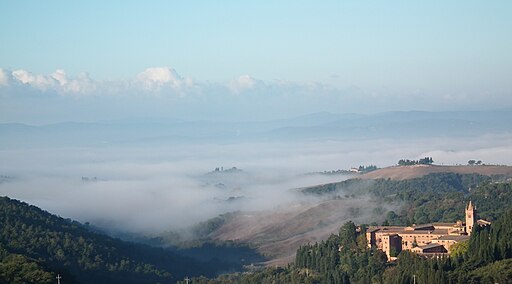| |
|
 |
 |
|
| I T |
The parish church of Badia a Rofeno, near Asciano, before 2010 [1]
|
|
![Toacana ] Galleria di immagini](../../titels/albump.gif) |
|
| |
 |
|
|
| |
|
The Crete Senesi | Church and Monastery San Cristoforo a Rofeno, also called Badia a Rofeno, in the territory of Asciano
|
|
|
|
| |
|
The Monastery of Saint Cristoforo in Rofeno is a sacred building in Badia a Rofeno. It is mentioned since 1031. While the church keeps the Cistercian architectonic typologies, the annexed cloister shows the last, visible eighteenth-century interventions, made by the Olivetans, who, since 1375 had taken the whole complex. Behind the main altar, the monks put a big altarpiece by Ambrogio Lorenzetti with Saint Michele and the Benedictine Saints, maybe fruit of an assembly at the beginning of the XVI century, to which dates back the carpentry which frames it and which was probably carved by the friar Raffaello from Reggio, at the same time as the making of the wooden ciborium, which is kept, together with the polyptych, in the Museum of the Sacred Art of Asciano.
|
|
|
|
| |
|
|
Mappa San Cristoforo a Rofeno, Asciano | Ingrandire mappa
|
The Val d'Orcia is one of the latest Italian entries (2004) of the UNESCO World Heritage List. Its distinctive landscape of rolling chalk hills (the Crete), shaped in the 14th and 15th centuries to reflect an idealized model of good governance, and celebrated in the paintings of the Sienese school, has become an icon of the Renaissance that profoundly influenced the development of landscape thinking worldwide. [2]
Rofeno Abbey Poliptych by Ambrogio Lorenzetti
|
Ambrogio Lorenzetti (c. 1290 – 9 June 1348) was an Italian painter of the Sienese school. He was active from approximately 1317 to 1348. He painted The Allegory of Good and Bad Government in the Sala dei Nove (Salon of Nine or Council Room) in the Palazzo Pubblico (or Town Hall) of Siena. His elder brother was the painter Pietro Lorenzetti.
The panel Saint Michael the Archangel was the central part of a polyptych executed for the Benedictine monastery church established by Guido Tarlati, bishop of Arezzo, in 1319.
|
|
|
| |
|
 |
|
|
Proloco Asciano | www.prolocoasciano.it
San Cristoforo a Rofeno, Asciano | La scheda su toscana.it, web.rete.toscana.it.
Traveling in Tuscany | Collegium Vocale Crete Senesi
Rofeno Abbey Poliptych by Ambrogio Lorenzetti
Museo | More info at museum site
Tryptich at Google Art | sAGysy5zysRGtQ at Google Cultural Institute maximum zoom level
Palazzo Corboli Civic Archeological and Sacred Art Museum (Details of room on Google Art Project)
|
|
 |
| |
|
Saint Michael the Archangel slaying the Dragon between Saints Bartholomew and Benedict; Madonna with Child, Saint John the Evangelist and Saint Ludwig of Tolouse, Tempera on wood, Museo d'Arte Sacra, Asciano
|

|
|
|
 |
|
 |
|
|
Crete Senesi presso Asciano
|
|
Monte Oliveto Maggiore |
|
Monte Oliveto Maggiore, Campanile]
|
 |
|
 |
|
 |
| Crete Senesi, balle di fieno |
|
Pieve di Santo Stefano a Cennano. Absidi
|
|
Chiusure and the Campanile of Santa Maria di Monte Oliveto Maggiore
|
| |
|
|
|
|
|
#poderesantapia |


Hidden secrets in Tuscany | Holiday house Podere Santa Pia
|
 |

[1] Foto di LigaDue, licenziato in base ai termini della licenza Creative Commons Attribution-Share Alike 4.0 International
[2] Preserving the cultural wealth embodied in this corner of Tuscany is also a matter of assessing its seismic hazard correctly. As a first step toward this end, we revised the local seismic history. According to the current national catalogue, the Crete are a low- seismicity area intervening between two earthquake clusters centered on Siena (north) and Mount Amiata (south); the local earthquakes on record are very few, with middle to low epicentral intensities and none earlier than the second half of 17th century. However, the fortuitous discovery of a recent (1802) damaging earthquake unrecorded by any of the extant catalogues suggested that the current interpretation was more likely to derive from the little interest shown in the area having by previous studies rather than from an actual lack of data. By retrieving the memory of several forgotten damaging earthquakes (from 1449 onwards) and increasing the data set of the already known events, our study does significantly improve the Crete seismic history.
Castelli, Viviana & BERNARDINI, Filippo. (2017). UNEARTHING EARTHQUAKES IN THE SIENESE CRETE: HOW WE IMPROVED THE SEISMIC CATALOGUE OF A LOW-SEISMICITY AREA (summary) | www.researchgate.net
|
Questo articolo è basato parzialmente sull'articolo Monastero di San Cristoforo a Rofeno dell' enciclopedia Wikipedia ed è rilasciato sotto i termini della GNU Free Documentation License.
|
|
|
| |
|
|
|
| |
|
|
|
| |
|
|
|
| |
|
|
|
| |
|
|
|
| |
|
|
|
|